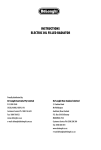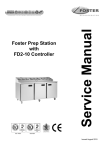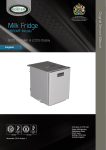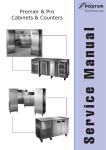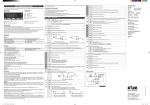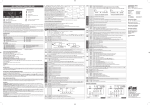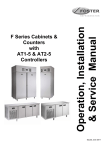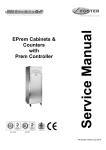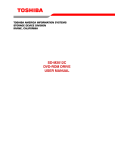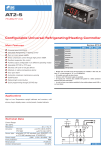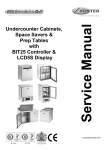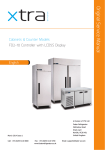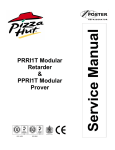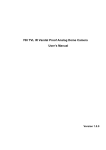Download Service Manual - Foster Refrigerator
Transcript
ISO 14001 ISO 9001 Service Manual Slimline Range with FD2-10 Controller Issued August 2010 Contents Manual Information & Health & Safety Notes Environmental Management Policy Disposal Requirements Cabinet & Counter Description Controller Relevance Table & Operation User Functions Defrost Operation & Fuzzy Logic Wiring Diagram for Defrost & Technical Data Configuration of Parameters Slimline Controller Default Individual Unit Controller Parameter Values Technical Data Wiring Diagrams & Probe details Troubleshooting & Notes 1 2 2 3 3-4 4-5 5 6 6 7-10 11-13 14 15-17 18-20 Service Manual Information The products and all information in this manual are subject to change without prior notice. We assume by the information given that the person(s) working on these refrigeration units are fully trained and skilled in all aspects of their workings. Also that they will use the appropriate safety equipment and take or meet precautions where required. The service manual does not cover information on every variation of this unit; neither does it cover the installation or every possible operating or maintenance instruction for the units. Health & Safety Warnings and Information Make sure the power supply is turned off before making any electrical repairs. To minimise shock and fire hazards, please do not plug or unplug the unit with wet hands. During maintenance and cleaning, please unplug the unit where required. Care must be taken when handling or working on the unit as sharp edges may cause personal injury, we recommend the wearing of suitable PPE. Ensure the correct moving and lifting procedures are used when relocating a unit. Do NOT use abrasive cleaning products, only those that are recommended. Never scour any parts of the refrigerator. Scouring pads or chemicals may cause damage by scratching or dulling polished surface finishes. Failure to keep the condenser clean may cause premature failure of the motor/compressor which will NOT be covered under warranty policy. Do NOT touch the cold surfaces in the freezer compartment. Particularly when hands are damp or wet, skin may adhere to these extremely cold surfaces and cause frostbite. Please ensure the appropriate use of safety aids or Personnel Protective Equipment (PPE) are used for you own safety. 1 Environmental Management Policy for Service Manuals and Duets. Product Support and Installation Contractors Foster Refrigerator recognises that its activities, products and services can have an adverse impact upon the environment. The organisation is committed to implementing systems and controls to manage, reduce and eliminate its adverse environmental impacts wherever possible, and has formulated an Environmental Policy outlining our core aims. A copy of the Environmental Policy is available to all contractors and suppliers upon request. The organisation is committed to working with suppliers and contractors where their activities have the potential to impact upon the environment. To achieve the aims stated in the Environmental Policy we require that all suppliers and contractors operate in compliance with the law and are committed to best practice in environmental management. Product Support and Installation contractors are required to: 1. Ensure that wherever possible waste is removed from the client‟s site, where arrangements are in place all waste should be returned to Foster Refrigerator‟s premises. In certain circumstances waste may be disposed of on the client‟s site; if permission is given, if the client has arrangements in place for the type of waste. 2. If arranging for the disposal of your waste, handle, store and dispose of it in such a way as to prevent its escape into the environment, harm to human health, and to ensure the compliance with the environmental law. Guidance is available from the Environment Agency on how to comply with the waste management „duty of care‟. 3. The following waste must be stored of separately from other wastes, as they are hazardous to the environment: refrigerants, polyurethane foam, and oils. 4. When arranging for disposal of waste, ensure a waste transfer note or consignment note is completed as appropriate. Ensure that all waste is correctly described on the waste note and include the appropriate six-digit code from the European Waste Catalogue. Your waste contractor or Foster can provide further information if necessary. 5. Ensure that all waste is removed by a registered waste carrier, a carrier in possession of a waste management licence, or a carrier holding an appropriate exemption. Ensure the person receiving the waste at its ultimate destination is in receipt of a waste management licence or valid exemption. 6. Handle and store refrigerants in such a way as to prevent their emission to atmosphere, and ensure they are disposed of safely and in accordance with environmental law. 7. Make arrangements to ensure all staff who handle refrigerants do so at a level of competence consistent with the City Guilds 2078 Handling Refrigerants qualification or equivalent qualification. 8. Ensure all liquid substances are securely stored to prevent leaks and spill, and are not disposed of to storm drains, foul drain, or surface water to soil. Disposal Requirements If not disposed of properly all refrigerators have components that can be harmful to the environment. All old refrigerators must be disposed of by appropriately registered and licensed waste contractors, and in accordance with national laws and regulations. 2 Slimline Cabinet Range Description The cabinets are manufactured as a one piece foamed shell with the condensing unit located on the base of the 0 cabinet. All the cabinets conform to ISO Climate Class 5 (40 c with 40% RH) with the temperature being controlled by a microprocessor with digital temperature display. The refrigeration system is integral with an air-cooled condensing unit with the refrigerant being distributed into the evaporator controlled by capillary. This cooled air is circulated through the evaporator, via a fan in the storage area. To evaporate condensation, the plastic vaporiser tray has a hot gas line that is inserted into it. 0 0 The FSL400H & 800H have a temperature range of +1 c to +4 c with a timed off cycle defrost. 0 0 The FSL400L & 800L are different in that they have a temperature range of -18 c to -21 c with electric defrost set at 4 times per 24 hours. 0 0 The FSL400M & 800 are models designed for meat chilling and have a temperature range of -2 c to +2 c using R134a refrigerant. The coding „FSL‟ means Foster Slimline with the 400/800 afterwards being the respective net capacity in litres. If the model comes with an H or L this denotes High or Low temperature units as with a G meaning it has glass doors and M denoting meat. Both glass and solid doors are fitted with pivot hinges and also both have magnetic door gaskets. Only the solid doors have recessed door handles whereas the glass is surface mounted. On the glass door models the interior light, incorporating the on/off switch, is fitted to the top of the storage area at the front of the unit. All models fitted with lockable swivel castors to the front and swivel castors to the rear. Controller Relavance Table st 1 Serial Number Issued E5270966 E5270970 Model 400 800 Manufacturer Date from 09.08.2010 09.08.2010 Controller Operation FSL400 Probe Air 2.5M SN4K15H1 (00-556248) Probe Evap 2.5M SN4K15H2 (00-556251) FD2-10 Controller (00-556241) LCD 5S Display (00-555992) LCD5 Connecting Ribbon 3m (00-555814) (Normally only used on FSL800 Models) FSL800 Probe Air 4M SN4B40H1 (00-556289) Probe Evap 4M SN4B40H2B (00-556290) LCD 5S Display (00-555992) Indicators and Buttons Symbol Reason Button Use Alarm Info / Set Point Button Thermostat Output Manual Defrost / Decrease Button Fan Output Increase Button / Manual Activation Defrost Output Stand-by Button Activation of 2 nd parameter set 3 Display During normal operation the display shows either the temperature measured or one of the following indicators: Symbol Reason Defrost in progress Symbol Reason Condenser high pressure alarm Controller in stand-by Room high temperature alarm Condenser clean warning Room low temperature alarm Door open alarm Probe T1 failure Condenser high temperature alarm Probe T2 failure Information Menu The information available in the menu is shown below: Symbol Reason Symbol Reason Instant probe 1 temperature Minimum probe 1 temperature recorded Instant probe 2 temperature * Compressor working weeks ** Instant probe 3 temperature * Keypad state lock Maximum probe 1 temperature recorded * Displayed only if enabled (see configuration parameters) ** Displayed only if ACC > 0 User Functions Start Sequence For normal operation Press and hold the button for 3 seconds then release. If pressed and held for 5 seconds then released this will start the „Test Sequence‟. The test function is a defined sequence of events that will follow a prescribed pattern (dependent upon parameter values). In turn it will operate all electrical elements of the system, simulating a short operating pattern. This was designed to provide a quick and simple evaluation tool to use either during manufacturing or when servicing. To cancel the Test Sequence Press and release the button during the test sequence. If not pressed the test will continue and when complete the controller will wait for 1 min, then resume normal operation. (The controller will count to 530 then show „end‟. It will then show the current unit temperature) Access to the menu and information displayed Press and immediately release button With button Press button or select the data to be displayed to display the value To exit from the menu, press button or wait for 10 seconds. Set point: Display and modification Press button for at least half a second to display the set point. By keeping button pressed, use button minimum SPL and the maximum SPH limit) When button or is released, the new value is stored. 4 to set the desired value (adjustment is within the Reset of THI, TLO, CND recordings With button or select the data to be reset Display the value with button While keeping button pressed, use button . Standby When pressing the button for 3 seconds, will allow the controller to be put on a standby or output control to be resumed (with SB = YES only). When on Standby will be displayed. Selection of second parameter group It is possible to select control parameters between two different pre-programmed groups, in order for the fundamental control parameters to be adapted to changing needs. Changeover from Group I to Group II (and visa versa) may take place Manually by pressing for 2 seconds (with IISM = MAN), or Automatically when heavy duty conditions are detected (with IISM = HDD), or when IISM =D12 and the Auxiliary Input D12 is activated (the activation of D12 selects Group II). If IISM = NON, switchover to Group II is inhibited. The activation of Group II is signalled by the lighting up of relevant LED on the controller display. Defrost Automatic Defrost. Defrost starts automatically as soon as the time set with parameter DFT has elapsed. Time Defrost With DFM = TIM defrost takes place at regular intervals when the timer reaches the value DFT. For example, with DFM = TIM and DFT = 06, a defrost will take place every 6 hours. Defrost time count backup At the power–up, if DFB = YES, the defrost timer resumes the time count from where it was left off before the power interruption. Visa versa with DFB=NO, the time count restarts from 0. In stand-by the accumulated time count is frozen. Defrost type Once defrost has started, compressor and defrost outputs are controlled according to parameter DTY. If FID =YES, the evaporator fans are active during defrost. Resuming Thermostatic Cycle When defrost is over, if DRN is greater then 0, all outputs will remain off the DRN minutes, in order for the ice to melt completely and the resulting water to drain. Manual Defrost To initiate a manual defrost press and hold the defrost button for 2 seconds. Fuzzy Logic ‟Fuzzy Logic’ is an energy saving feature which enables the refrigeration system performance on specific models to be automatically adjusted during operation, for optimum energy performance whilst maintaining the correct internal storage temperature. When enabled it works by identifying periods of high and low usage and applying an appropriate temperature set point and defrost frequency. Additionally the evaporator fan(s) can be caused to cycle (providing „air stir‟ only) in low usage periods. „Fuzzy Logic‟ operation is controlled by parameter „IISM‟. Setting the value „HDD‟ for this parameter will cause the controller to automatically change between the „economy‟ and „performance‟ operating modes (the actual switching point sensitivity is controlled by parameter „HDS‟). Setting „IISM‟ to „non‟ will disable the „Fuzzy Logic‟ function. When enabled, and upon the product being switched „On‟, „Fuzzy Logic‟ will automatically start using the „economy‟ settings to control the operation of the temperature and defrost („SP‟, „HYS‟, and „DFT‟). The controller will remain operating to the values of these settings unless; through monitoring of the air temperature, evaporator temperature and door switch (where T2 probe and door switch are fitted), the controller determines that the usage frequency or temperature variation indicates more demanding operational conditions. In such circumstances the controller will switch to the „performance‟ mode (utilising parameters „IISP‟, „IIHY‟ and „IIDF‟). Upon usage or temperature variation reducing sufficiently the controller will revert back to the „economy mode‟. The evaporator fan operation works in conjunction with, but separate from „Fuzzy Logic‟. Determined by parameter „FCM‟, and normally set to „TIM‟, the fans will run continuously when the compressor is on, subject to the door switch operation (where fitted). During the compressor off cycle the fans will operate in an „air stir‟ mode (controlled by parameters „FT1‟, „FT2‟ and „FT3‟). Where „FCM‟ is set to „non‟ the fans will run continuously. The fan cycle mode during the „performance‟ operation of „Fuzzy Logic‟ is controlled by parameter „IIFC‟. 5 Parameter Setting Wiring Diagram for Synchronising Defrost Start and Termination Technical Data Power Supply FD2-10 230Vac±10%, 50/60Hz, 3W Relay Output Compressor Defrost Evap. Fan Auxiliary Loads 1 16(8) A 240Vac 16(4) A 240Vac 16(4) A 240Vac 8(2) A 240Vac Measurement Range -50…120°C, -55…240°F -50 / -9.9…19.9 / 80°C (NTC 10K Only) Measurement Accuracy <0.5°C within the measurement range CE (Reference norms) EN60730-1; EN60730-2-9 EN55022 (Class B) EN50082-1 Input NTC 10KΩ@25°C Configuration Parameters To get access to the parameter configuration menu, press With button or + for 5 seconds select the parameter to be modified. Press button and hold briefly to display the value. On releasing the button the controller will then show the next parameter. By keeping button pressed, use button or to set the desired value. On releasing the button the controller will store the amended value and then show the next parameter. To exit from the setup, press button or wait for 30 seconds. 6 FD2-10 Default Parameter Values Parameter 1°C 2°C °F Description Readout Scale: Range -50/-9.9…. 19.9/80°C (With INP = SN4 Only) Range -50 …. 120°C Range -55 …. 240°F SPL -50 … SPH Minimum Limit for SP setting 1 SPH SPL …120° Maximum limit for SP setting 3 SP SPL … SPH Temperature set point to be achieved 2 C-H REF HEA Temperature Control mode: Refrigeration Heating REF HYS 1 … 10° Off/On Thermostat differential 3 CRT 0 … 30min Compressor Rest Time 2 CT1 0 … 30min Thermostat run time with faulty T1 probe. (CT1 = 0 output with faulty T1 will always be off) 6 CT2 0 … 30min Thermostat off time with faulty T1 probe. (CT2=0 & CT1 = >0 output with faulty T1 will always be on) 4 CSD 0 … 30min Compressor stop delay after door has been opened (Only if DS = YES) 1 SCL Range Default FD2-10 2°C Non TIM FRO Defrost Start Mode: Defrost function is disabled Regular time defrost Defrost time elapses only in condition of frost accumulation DFT 0…99 Hours Time interval between defrosts DFB YES NO Defrost timer clock Following mains interruption, timer resumes count Following mains interruption, timer restarts from zero YES DLI -50.. 120° Defrost end temperature (Only if T2 = EPO) N/A DTO 1 … 120min Maximum defrost duration 20 OFF ELE GAS Defrost Type: Timed off cycle defrost (compressor and heater off) Electric heater defrost (compressor off, heater on) Hot gas defrost (compressor and heater on) DPD 0 … 240 sec Evaporator pump down. Timed pause at start of defrost 0 DRN 0 … 30min Drain down period 2 RT LT SP DEF Defrost display mode: Real (actual) air temperature Last temperature display before start of defrost The current set point value. “DEF” DFM DTY DDM 7 TIM 6 OFF DEF Defrost display delay period Time DDM is shown following defrost termination DDY 0… 60 min FID YES NO FDD -50 … 120° Evaporator fan restart temperature following defrost (Only if T2 = EPO) 5 FTO 0…120 min Maximum evaporator fan stop period following defrost 3 FDS 0…120 sec Minimum evaporator fan stops (following door opening etc) 20 NON FCM TMP Tim Fans in defrost: Fans run during defrost Fans do not run during defrost Evaporator fan mode during thermostatic control: Fan(s) run continuously Temperature based control. When compressor is on, fans are on. When compressor is off, fans run as long as temperature difference Te-Ta > FDT. Fans on again with FDH Time based control. When compressor is on, fans are on. When compressor is off, fans in accordance to parameters FT1, FT2 and FT3. 10 YES TIM FDT -120 … 0° Te-Ta difference for fans to turn off after compressor stopped. (Only if T2 = EPO and FCM = TMP) -1 FDH 1 … 120° Temperature differential for evaporator fan restart. (Only if T2 = EPO and FCM = TMP) 3 FT1 0 … 180 Sec Fan stop delay after compressor stop. 15 FT2 0 … 30min Timed fan stop following FT1 (With FT2 = 0 the fans remain on all the time). 3 FT3 0 .. 30min Timed fan run following FT2 (With FT3 = 0 and FT2 >0 the fans remain off all the time. 2 ATM NON ABS REL Alarm threshold configuration: All temperature alarms are inhibited The value set in ALA and AHA represent actual alarm set points The values set in ALR and AHR are alarm differentials which relate to SP and SP + HYS REL ALA -50 … 120° Low temperature alarm threshold AHA -50 … 120° High temperature alarm threshold ALR -12 … 0° Low temperature alarm differential (With ALR = 0 the low temperature alarm is excluded) -5 AHR 0 … 12° High temperature alarm differential (With AHR = 0 the low temperature alarm is excluded) 5 ATI T1 T2 Alarm probe: Air temperature probe used for alarm detection Evaporator temperature probe used for alarm detection T1 ATD 0… 120min Delay before alarm temperature warning 90 ADO 0… 30min Delay before door open alarm warning 8 8 NON ALR STP Operation in case of high condenser alarm (T2 = CND) High condenser temperature alarm inhibited Condenser warning – „HC‟ displayed, alarm sounds As „ALR‟ with compressor stopped and defrosts suspended AHT -50 … 120° Condenser alarm temperature (T2 = CND) 65 ACC 0…52 Weeks Condenser cleaning period. (With ACC = 0 condenser cleaning is disabled) 0 AHM NON NON Switchover method to second parameter set: Second parameter set is excluded IISM MAN IISL HDD D12 -50 . IISH Second parameter set is activated/ deactivated by button Second parameter activated by „heavy‟ usage Second parameter set activated by D12 input (D12 = IISM) Minimum limit for IISP setting IISH IISL .. 120° Maximum limit for IISP setting 1 IISP IISP…IISH Temperature set point to be achieved in „Mode 2‟ 1 IIHY 1 … 10° Off/on thermostat differential in „Mode 2‟ 3 NON IIFC TMP TIM Evaporator fan mode during ‘Mode 2’ thermostatic control: Fans(s) run continuously Temperature based control. When compressor is on, fans are on. When compressor is off, fans run as long as temperature difference Te-Ta>FDT. Fans on again with FDH Time based control. When compressor is on, fans are on. When compressor is off, fans in accordance to parameters FT1, FT2 and FT3. HDD 1 NON HDS 1…5 Controller sensitivity for switch over between „Modes‟ and 2. (1 = minimum, 5 = maximum) 3 IIDF 0 … 99hours Time interval between defrosts in „Mode 2‟. 6 SB YES No Standby button operation: Standby button enabled Standby button disabled YES DS YES NO Door switch operation (switch made when door closed): Door switch enabled Door switch disabled YES NON HPS IISM RDS DS2 Configuration digital input operation: Digital input 2 not activated High pressure alarm when contact opens „Mode 2‟ parameters active when contact closes Defrost initiated when contact closes Second door switch function (operated „in series‟ with DS) NON NON Light control mode: Digital input 2 not activated DI2 MAN LSM DOR NDR Light output operation is activated/deactivated by button (With OA1 = LGT) Light output is switched on when door is opened (With OA1 = LGT and DS = YES) Light output is switched off when door is opened. (With OA1 = LGT and DS = YES) 9 NON OA1 NON 0-1 LGT AL0 AL1 Auxiliary relay operation: Output disabled (always off) Contacts open/close with standby/on mode Output enabled for light control Contacts open when an alarm condition occurs Contacts close when an alarm condition occurs (Relay contacts open when in standby mode) NON SN4 INP SN4 ST1 Temperature sensor(s) type: 10k NTC type thermistor (red writing) 1k PTC type thermistor (Black Writing) OS1 -12.5...12.5°C Air temperature probe (T1) offset. NON EPO CND T2 Probe function: T2 Probe disabled Evaporator temperature monitoring Condenser temperature monitoring OS2 -12.5…12.5°C T2 probe temperature offset 0 TLD 1 … 30min Delay for min (TLO) and max. (THI) temperature logging 10 SIM 0 … 100 Display Slowdown 5 ADR 1… 255 FD2-10 address for PC communication 1 T2 10 0 NON 253 SCL 1C 200 SPL -50 o o Mid o Max o Description FSL400M & FSL800M Min FSL800L Par FSL800H Reg FSL400L FOSTER FD2-10 FSL400H Individual Unit Controller Parameter Values C I C I O 2°C 2°C 2°C 2°C 2C o F 2C Readout scale. ….. SPH Minimum limit for SP setting. 1 -21 1 -21 -2 o 202 SPH SPL ….. 120 Maximum limit for SP setting. 3 -19 3 -19 0 204 SP SPL ….. SPH Temperature set point to be achieved. 1 -21 1 -21 -2 268.1 C-H REF ….. HEA Temperature control mode. REF REF REF REF REF Off / On thermostat differential. 4 4 4 4 2 o o 214 HYS 1 ….. 10 216 CRT 0 min ….. 30 min Compressor rest time. 2 2 2 2 2 217 CT1 0 min ….. 30 min Thermostat run time with faulty T1 probe. 6 6 6 6 6 218 CT2 0 min ….. 30 min Thermostat off time with faulty T1 probe. 4 4 4 4 4 219 CSD 0 min ….. 30 min Compressor stop delay after door has been opened. (Only if DS = YES). 1 1 1 1 1 220 DFM FRO TIM TIM TIM TIM TIM DFT 6 6 6 6 6 268.4 DFB TIM 99 hours YES Defrost start mode. 221 NON 0 hours NO YES YES YES YES YES Defrost end temperature (Only if T2 = EPO). 20 20 20 20 20 Maximum defrost duration. 20 20 20 20 20 o ….. ….. o 206 DLI -50 ….. 120 223 DTO 1 min ….. 120 min Time interval between defrosts. Defrost timer clock. 224 DTY OFF ELE GAS OFF ELE OFF ELE ELE 225 DPD 0 sec ….. 240 sec Evaporator pump down. Timed pause at start of defrost. 0 0 0 0 0 226 DRN 0 min ….. 30 min Drain down period. 2 2 2 2 2 227 DDM RT SP, DEF LT DEF DEF DEF DEF DEF 228 DDY 0 min ….. 60 min 10 10 10 10 10 267.5 FID NO ….. YES YES NO YES NO NO o Evaporator fan restart temperature following defrost. (Only if T2 = EPO). 5 0 5 0 0 3 3 3 3 3 o Defrost type. Defrost display mode. Defrost display delay period. Fans in defrost. 207 FDD -50 ….. 120 229 FTO 0 min ….. 120 min Maximum evaporator fan stop period following defrost. 237 FDS 0 sec ….. 120 sec Minimum evaporator fan stop (following door opening etc.). 230 FCM NON TIM TMP Evaporator fan mode during thermostatic control. 11 20 20 20 20 20 TIM TIM TIM TIM TIM o o ….. 0 1 ….. 120 FT1 0 sec ….. 180 sec 235 FT2 0 min ….. 30 min 236 FT3 0 min ….. 30 min 238 ATM NON REL ABS ….. o o 232 FDT -120 233 FDH 234 208 209 ALA AHA o o -50 o -50 o o 120 ….. 120 o Te-Ta difference for fans to turn off after compressor stopped. (Only if T2 = EPO and FCM = TMP). Temperature differential for evaporator fan restart. (Only if T2 = EPO and FCM = TMP). Fan stop delay after compressor stop. Timed fan stop following FT1. (With FT2 = 0 the fans remain on all the time). Timed fan run following FT2. (With FT3 = 0 & FT2 > 0 the fans remain off all the time). Alarm threshold configuration. -1 -1 -1 -1 -1 3 3 3 3 3 15 15 15 15 15 0 0 0 0 0 2 2 2 2 2 REL REL REL REL REL Low temperature alarm threshold. -2 -2 -2 -2 -2 High temperature alarm threshold. Low temperature alarm differential. (With ALR = 0 the low temperature alarm is excluded). High temperature alarm differential. (With AHR = 0 the low temperature alarm is excluded). Alarm probe. 8 8 8 8 8 -5 -5 -5 -5 -5 5 5 5 5 5 T1 T1 T1 T1 T1 239 ALR -12 ….. 0 240 AHR 0 o ….. 12 241 ATI T1 ….. T2 242 ATD 0 min ….. 120 min Delay before alarm temperature warning. 90 90 90 90 90 243 ADO 0 min ….. 30 min Delay before door open alarm warning. 8 8 8 8 8 244 AHM NON STP ALR NON NON NON NON NON 65 65 65 65 65 0 0 0 0 0 HDD HDD HDD HDD HDD Minimum limit for IISP setting. 1 -21 1 -21 -2 210 AHT 245 ACC 247 IISM 201 IISL o -50 0 weeks NON o -50 ….. o o HDD, DI2 120 52 weeks MAN ….. IISH o ….. Operation in case of high condenser alarm (T2 = CND). Condenser alarm temperature (T2 = CND). Condenser cleaning period. (With ACC = 0 condenser cleaning is disabled). Switchover method to second parameter set. 203 IISH IISL ….. 120 Maximum limit for IISP setting. 1 -21 1 -21 0 205 IISP IISL ….. IISH Temperature setpoint to be achieved in 'Mode 2'. 1 -21 1 -21 -2 Off / On thermostat differential in 'Mode 2'. 4 4 4 4 2 NON NON NON NON NON 3 3 3 3 3 6 6 6 6 6 Standby button operation. YES YES YES YES YES NO NO NO NO NO o o 215 IIHY 1 ….. 10 231 IIFC NON TIM TMP 246 HDS 1 ….. 5 222 IIDF ….. 268.7 SB 0 hours NO ….. 99 hours YES 268.0 DS NO ….. YES Door switch operation (switch made when door closed). 251 DI2 NON IISM, RDS, DS2 HPS Configurable digital input operation. NON NON NON NON NON 248 LSM NON DOR, NDR MAN Light control mode. NON NON NON NON NON Evaporator fan mode during 'Mode 2' thermostatic control. Controller sensitivity for switch over between 'Modes' 1 and 2. (1 = minimum, 5 = maximum). Time interval between defrosts in 'Mode 2'. 12 249 OA1 NON LGT, AL0, AL1 0-1 Auxiliary relay operation. 0-1 0-1 0-1 0-1 0-1 268.2 INP ….. SN4 Temperature sensor(s) type. SN4 SN4 SN4 SN4 SN4 256 OS1 ….. 12.5 C 0 0 0 0 0 250 T2 EVP CND NON EVP NON EVP EVP 251 OS2 ….. 12.5 C T2 probe temperature offset. 0 0 0 0 0 252 TLD ST1 o 12.5 C NON o 12.5 C 1 min ….. 30 min Delay for min. (TLO) and max. (THI) temperature logging. 10 10 10 10 10 254 SIM 0 ….. 100 Display slowdown. 5 5 5 5 5 255 ADR 1 ….. 255 FD2-10 address for PC communication 1 1 1 1 1 o o Air temperature probe (T1) offset. T2 probe function. Parameters ALA and AHA will not be visible when ATM is set at REL. Parameters ALR and AHR will not be visible if ATM is changed to ABS. 13 Technical Data Slimline Cabinets Model FSL400H FSL400L FSL400M FSL800H FSL800L FSL800M Storage Temp 0 0 +1 c to +4 c 0 0 -18 c to -21 c 0 0 -2 c to +2 c 0 0 +1 c to +4 c 0 0 -18 c to -21 c 0 0 -2 c to +2 c Gas Gas Charge Compressor Capillary Defrost Type Voltage R134a R404a R134a R134a R404a R134a 310 grms 285 grms 310 grms 400 grms 350 grms 400 grms FR75GX SC15CL FR75GX SC12GX SC21CLX SC12GX 3.0m x 0.042 2.5m x 0.042 3.0m x 0.042 3.0m x 0.054 3.0m x 0.054 3.0m x 0.054 Timed Off Cycle Electric 230/50/1 230/50/1 230/50/1 230/50/1 230/50/1 230/50/1 Timed Off Cycle Electric Power Consumption Watts Amps 280 2.1 584 3.8 520 758 3.6 4.1 Fuse Rating 13amps 13amps 13amps 13amps Technical Data Slimline Cabinets with R290 Refrigerant Model FSL400H Storage Temp 0 0 +1 c to +4 c Gas Gas Charge Compressor Capillary Defrost Type Voltage R290 150grms TL5CNX 3.0m x 0.042 Timed Off Cycle 230/50/1 14 Power Consumption Watts Amps 280 2.1 Fuse Rating 13amps Slimline High Temp (Integeral and Remote Models) Wiring Diagram 15 Slimline Low/Meat Temp (Integeral and Remote Models) Wiring Diagram 16 Air and Evaporator Probe Details / Diagram Probe Air 2.5M SN4K15H1 (00-556248) Probe Evap 2.5M SN4K15H2 (00-556251) 17 Troubleshooting Problem Compressor will not start The temperature is too cold Possible Cause No voltage in socket Electrical conductor or wires may be cut Defective electrical component: thermostat, relay, thermal protector etc Use voltmeter to check Use ohmmeter to check for continuity Replace defective component Compressor motor has a winding open or shorted Measure ohmic resistance of main and auxiliary winding using ohmmeter. Compare with correct values Compressor stuck Change compressor Temperature control contacts are open Incorrect wiring Fuse blown or circuit breaker tripped. Power cord unplugged Controller set too high Cabinet in defrost cycle Repair or replace the contacts Check wiring diagram and correct Replace fuse or reset circuit breaker Plug in power cord. Set controller to lower temperature. Wait for defrost cycle to finish Controller is set at a very cold position Controller does not disconnect the condensing unit Control contacts are stuck closed The temperature is not cold enough Solution Set to warmer position and check if the compressor stops according to controllers operating range. Check the insulation of the thermostat. If problem persists, change the thermostat Change the control. Check amperage load Defective or incorrect temperature control Determine correct control and replace. Controller is set at a very warm position Adjust to colder setting Condenser is dirty Clean condenser The refrigerator has been placed at an inadequate location The unit must not be near stoves, walls that are exposed to the sun, or places that lack sufficient air flow. Compressor is inefficient or there is a high pressure due to the air in the system If there is air in the system, purge and recharge Iced up evaporator coil Restriction in system The refrigerator has been used improperly Too many door openings Excessive heat load placed in cabinet The refrigerator has been overcharged with the refrigerant gas 18 Check temperature control, refrigerant charge, and defrost mechanism. Remove all ice manually and start over. Locate exact point of restriction and correct The shelves must never be covered with any type of plastic or other material that will block the circulation of cold air within the refrigerator. Advise user to decrease if possible Advise user not to put in products that are too hot. Check to see if condensation or ice crystals have formed on the suction line. If so, charge with the correct amount of gas. Fuse blown or circuit breaker tripped Find the location of gas leak in order to seal and replace the defective component. Change the drier. Perform a good vacuum and recharge unit. Check electrical connections and make sure that the fan blade isn‟t stuck. Replace the fan motor if it doesn‟t work. Re-arrange product to allow for proper air flow. Make sure there is at least four inches of clearance from evaporator. Replace fuse or reset circuit breaker. Wires or electrical components are in direct contact with metallic parts. Check for appropriate insulation on the connections of each component. The refrigerator is not properly levelled Check if the noise goes away after you level the refrigerator The refrigerant gas is leaking The evaporator and/or condenser fans are not working Blocking air flow Electrical Shocks Noise The condenser is not fastened correctly. Copper tubing is in contact with metal The evaporator and/or condenser fans are loose Compressor has an internal noise Loose part(s) Extreme condensation inside the refrigerator The refrigerator had been placed at an inadequate location Set the controller to a warmer position & check to see if compressor stops as should. This type of occurrence is caused by local climatic conditions and not by the refrigeration unit. Check the door and/or the magnetic gasket. Adjust the door hinges if needed; replace the gasket if broken. The unit must not be near sources that produce too much heat. The light switch is “off” position Press the light switch to “on” position Controller is set at a very cold position The outside environment‟s relative humidity is very high (over 75%) The refrigerator door wont shut completely No illumination (Glass door models only) False contact on the light switch, the fluorescent tube, or the ballast Light switch, ballast and/or fluorescent tube are damaged Condensing unit runs for long periods of time While the compressor is working, check to see if metal parts are in contact with one another and/or if the screws that fasten the condenser are tightened. Check if the fans are securely fastened. Also, check if the fan blades are loose, broken or crooked. If so, change the faulty blade. If the noise persists after all other measures have been taken, it may be originating from the compressor. Locate and tighten loose part(s) Excessive amount of warm product placed in cabinet Prolonged door opening or door ajar Door gasket(s) not sealing properly 19 Inspect all connections Replace the damaged component. Advise user to leave adequate time for products to cool down Advise user to ensure doors are closed when not in use and to avoid opening doors for long periods of time. Ensure gaskets are snapped in completely. Remove gasket and wash with soap and water. Check condition of gasket & replace if necessary Dirty condenser coil Clean condenser coil Evaporator coil iced over Unplug unit and allow coil to defrost. Make sure thermostat is not set too cold. Ensure that door gasket(s) are sealing properly. Select manual defrost and ensure system works. Notes 20 Foster European Operations France Foster Refrigerator France SA Tel: (33) 01 34 30 22 22. Fax: (33) 01 30 37 68 74. Email: [email protected] Germany Foster Refrigerator Gmbh, Tel: (49) 781 990 7840. Fax (49) 781 990 7844. Email: [email protected] Foster Refrigerator Oldmedow Road Kings Lynn Norfolk PE30 4JU Tel: 0843 216 8833 Fax: 0843 216 4707 Website: www.fosterrefrigerator.co.uk Email: [email protected] a Division of „ITW (UK) Ltd‟ SLIMLINE FD2-10/SM 08/10 21






















